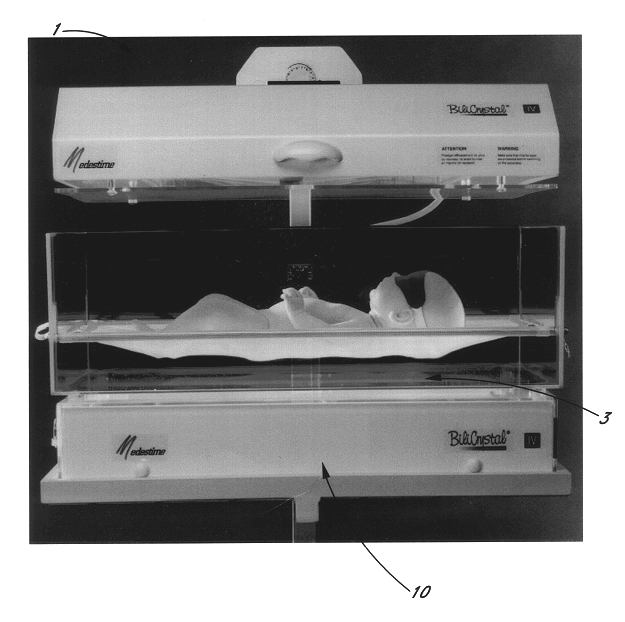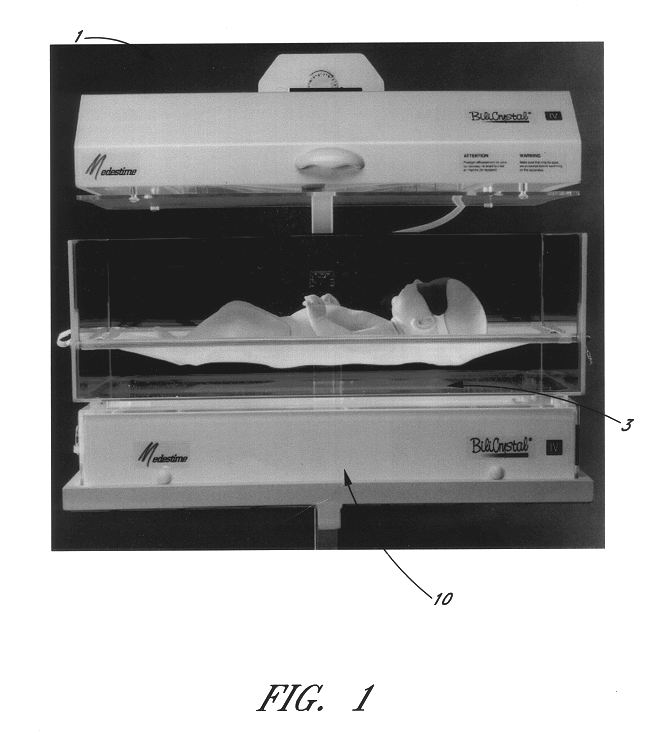Intensive multidirectional phototherapy device
- Summary
- Abstract
- Description
- Claims
- Application Information
AI Technical Summary
Benefits of technology
Problems solved by technology
Method used
Image
Examples
example 1
The phototherapy device 1 as shown in FIGS. 1 to 8 comprises a frame 2 supporting a light box 10 and a support 3 for the patient to be treated (which consists, in FIG. 1, of a hammock 6 suitable for the patient to be treated). Above the patient, the frame 2 also supports a single dome 5 illuminating the newborn from above.
The light box 10 as shown in FIGS. 2 to 5 has a succession of lamps 11, 12 arranged along the mutually opposed sides 15, 16 of the light box 10. Incorporated into the corners 8 and 9 of the light box 10 are fans 7 allowing effective flow of air towards extraction ducts 14, optionally via extraction cones as shown in FIG. 7.
Advantageously, the light box 10 also includes a temperature-control device, triggering a thermostat 17 which causes the lamps 11, 12 to be turned on or off and causes the aforementioned fans 7 to be operated.
As shown in FIG. 6, the device may include several domes 5 which can be adjusted by a knob 18 and leaves between the said domes 5 a space 1...
example 2
The phototherapy device of the invention was used to treat various newborns suffering from serious icterus, allowing intense illumination of light, particularly of the blue component delivered by the tube lamps, having values of greater than 2 mW per cm.sup.2, preferably values greater than 4 mW per cm.sup.2, of skin. The newborns being treated were kept under supervision by the monitoring means of the invention and under medical supervision, which guarantee that the infant is exposed to the light correctly.
The device of the invention makes it possible to fulfil the conditions in circular BH No. 21 from the French Ministry of Social Affairs, Health and Life, since it meets the main parameters required, namely a suitable light source, a suitable distance from the source to the infant, a treatment of the entire cutaneous surface of the infant with the proviso that no retinal lesion shall affect the newborn being treated, suitable centring of the infant beneath the light source, and a ...
PUM
 Login to View More
Login to View More Abstract
Description
Claims
Application Information
 Login to View More
Login to View More - R&D
- Intellectual Property
- Life Sciences
- Materials
- Tech Scout
- Unparalleled Data Quality
- Higher Quality Content
- 60% Fewer Hallucinations
Browse by: Latest US Patents, China's latest patents, Technical Efficacy Thesaurus, Application Domain, Technology Topic, Popular Technical Reports.
© 2025 PatSnap. All rights reserved.Legal|Privacy policy|Modern Slavery Act Transparency Statement|Sitemap|About US| Contact US: help@patsnap.com



